S-21: Health of Prisoners and Executions
Today, May 3, 2016, two witnesses gave testimony in front of the ECCC. First, former medic Mak Thim concluded his testimony by providing more information about the treatment of sick prisoners, medicine that was available, blood drawing, and prisoners who died at S-21. Second, former guard Him Huy took his stance. He was questioned about execution sites – in particular about Choeung Ek – and the authority structure at S-21. He also testified about Prey Sar. After the conclusion of Him Huy’s testimony tomorrow, the court will be in recess until the May 20. The week of May 9 until May 12 has been granted as an adjournment following a request by Nuon Chea Defense Team to adjourn for four weeks, and is followed by a regular recess for national holidays.
Recognition of new Defense Counsel: Doreen Chen
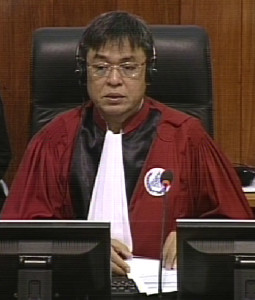
Trial Chamber President Nil Nonn
All parties were present, with Nuon Chea following the hearing from the holding cell. Counsel Doreen Chen was present in the court room to have her right to speak in the courtroom acknowledged. The Trial Chamber President Nil Nonn said that she was thereby recognized as a defense counsel. With this, she had the same rights and obligations as the national counsel for Nuon Chea.
Sick prisoners
The floor was granted to the Co-Prosecution to continue the questioning of Mak Thim. Senior Assistant Prosecutor Dale Lysak wanted to know whether he saw nails pulled out and wounds on the back of prisoners throughout the regime, which the witness confirmed. He would wash and clean the wounds with salty water. The wounds would dry in three or four days after he cleaned them. They were small and large and cut through the outer skin. Asked whether prisoners died, he recounted that he saw a dead body every three or four days or in a week at S-21. They would be carried on a stretcher and buried outside the compound. He was also ordered to bury bodies outside the compound wherever they would see an “open field” around the compound. He claimed that he was not a chief, which was why he had to report to chief Try. Huor was his group chief.
Mr. Lysak showed a report on ill prisoners at S-21, but the witness said that he had difficulties reading.[1] Mr. Lysak explained that the first pages were a list of 46 “seriously ill prisoners”. Mr. Thim could not remember someone called Pao who worked in the medical unit. However, he confirmed knowing “a young medic” called Dan. Mr. Lysak read an excerpt of Dan’s testimony, who had said that Pao was his chief and later arrested.[2] Mr. Thim replied that he vaguely remembered the name Pao. Mr. Lysak said that this person had been listed in the new OCIJ S-21 list and then gave the witness several lists of prisoners who had died from disease. [3] [4] Mr. Thim said that most of the prisoners who died were young: 30 years or younger. When Mr. Lysak asked why this was the case, Mr. Koppe objected and said that the witness would not be able to give information due to his limited knowledge as a medic. The objection was overruled, but the witness could not answer the question.
Mr. Lysak then inquired whether there were enough properly trained doctors to effectively and properly treat the prisoners. He replied that medics were assigned to different floors of each building. This prompted Mr. Lysak to refer to the witness’s OCIJ interview, in which he had said that the French medicine that was still present had expired, no new medicine came in, and that the treatment was not effective in general.[5] The witness answered that the medicine unit in Ta Khmao produced herbal medicine for the treatment of dysentery. A large percentage of medicine produced there was for S-21 prisoners. Mr. Lysak inquired whether he remembered prisoners at S-21 who committed suicide, which the witness did not.[6]
Blood drawing

International Senior Assistant Prosecutor Dale Lysak
Asked about blood extraction, he said that he saw bags with blood under a staircase, but that he did not know whether blood was drawn. The building was located to the east of his office.
There as a separate house, which was not accommodating the medics. It was located outside the gate and around twenty or thirty meters away from the medic house. He did not ask the chief of medics, Huor, about the blood, because he was terrified. Mr. Lysak read an excerpt of his Written Record of Interview: he had said that Huor told him about the blood drawing and that he saw thirty to forty prisoners whose blood had been drawn.[7] Mr. Lysak inquired where he saw these people. Mr. Thim said that he had never witnessed the incident himself, but only saw the bags of blood. Mr. Lysak presented lists of prisoners from the blood drawing section.[8] Mr. Lysak asked whether he knew a medic called Rin who worked with Try. Mr. Thim said that he could not remember this name. He could remember Dan and Tha. Mr. Lysak gave reference to the testimony of Prak Khan and Duch, who both had mentioned this person.[9] The witness could still not remember.
The floor was granted to the Civil Party Lawyers. International Civil Party Lead Co-Lawyer Marie Guiraud asked whether he ever treated female prisoners. He denied this and said that they did not sustain any injuries. However, he brought pills to them. There were no female medics. When the medical unit lacked medicine, the medicine would be brought by the chiefs, but he did not know where the warehouse was for keeping medicine.
When administering the medicine, “they complained that they would die”. To counter this, he tried to treat them. Three or four prisoners were in a large room.
“They said they had no hope”.
He did not have the right to communicate with the prisoners aside from in his role as a medic. Ms. Guiraud said that Duch had referred to an incident in which an interrogator had entered a stick into the vagina of a female prisoner during interrogations.[10] She asked whether he had heard about this. Mr. Thim replied that he had not: he only focused on his work.
“I was quite young at the time”.
Ms. Guiraud asked whether he knew someone called Soeung (also spelled Seun). He replied that he could not remember. Nor could he remember other sexual abuses of female detainees. He recognized two or three of his former colleagues who were detained at S-21. His chief of the production unit was detained at S-21 later on. The witness’s testimony was unclear whether he was detained for having committed sexual assault. His name was Dam. He had not heard about an incident involving a person called Touch. With this, Ms. Guiraud finished her line of questioning and gave the floor to her Cambodian colleague Pich Ang.
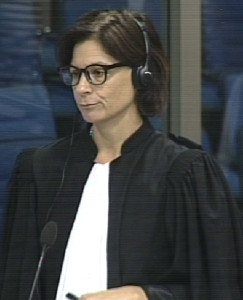
International Civil Party Lead Co-Lawyer Marie Guiraud
National Civil Party Lead Co-Lawyer asked how many medical staff members there were in the medical unit. He replied that there were between ten and fifteen. Three additional ones were responsible for treating staff members. He worked there for around a year, but knew that S-21 had been established “much longer than that”. Mr. Ang inquired whether he knew a girl who dressed as a boy and had short hair with the name Chantha, which the witness denied. Medical staff were between sixteen and twenty years old, but mostly seventeen or eighteen. He started working when he was thirteen or fourteen years old. The ten people who were in his unit were around his age.
Judge Jean-Marc Lavergne asked where the salty water came from that he cleaned the wounds with. He answered that they boiled water and dissolved salt in it. “There was plenty of salt in the kitchen”. They used mosquito-nets and cotton for bandages that they received from the chief. Judge Lavergne inquired whether he saw wounds from nails that had been pulled out often. He replied that he saw them occasionally and not on a daily basis.
At this point, the President adjourned the hearing for a break.
Follow-up questions by Judge Jean-Marc Lavergne
After the break, Judge Jean-Marc Lavergne wanted to know what material they used for injections and how they sterilized it. He replied that this was not his main task, since he was mainly distributing pills. They boiled the syringes to sterilize them. They had B-12 and B-1 as medicine “to cure the prisoners whose limbs became swollen, or who became too exhausted”. He received this medicine from “the distributor”. The medicine was produced in Ta Khmao. There were prisoners who died “because of the abscess”. These abscesses sometimes emerged where they had inserted the injections. This happened around two or three times.
Judge Lavergne then inquired whether there were cases of insanity amongst the prisoners, which the witness did not know. He did see physical diseases amongst the prisoners. Judge Lavergne wanted to 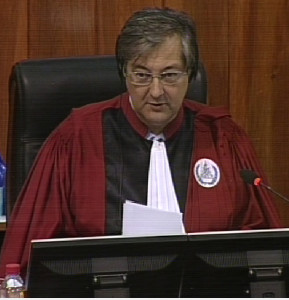 know whether he had met prisoners who wanted to commit suicide or had done so, which the witness denied. Judge Lavergne then referred to his Written Record of Interview and wanted to know who Chan Samreng was.[11] He recounted that Chan Samreng transported them from Kampong Chhnang “to the city”. He only saw him a few times. He could only vaguely remember the name Mam Nai and only knew Ta Chan Samreng.
know whether he had met prisoners who wanted to commit suicide or had done so, which the witness denied. Judge Lavergne then referred to his Written Record of Interview and wanted to know who Chan Samreng was.[11] He recounted that Chan Samreng transported them from Kampong Chhnang “to the city”. He only saw him a few times. He could only vaguely remember the name Mam Nai and only knew Ta Chan Samreng.
The floor was granted to Judge Fenz, who asked about the injections. He replied that he had “no idea what materials were used to produce those medicines”. Huor was the one who decided for the medicine to be used, mostly in cases of numbness and swelling. She asked him to be more specific about what he meant with “occasionally” having seen nails that were pulled out. He replied that these were not frequent encounters. When Judge Fenz pressed on, he said it was once every month or half a month. He only saw three or four prisoners who had open wounds on their backs. They all recovered and none of them died. With this, Judge Fenz finished her line of questioning.
The floor was granted to Nuon Chea Defense Team. Mr. Koppe asked whether he was born in 1962 or in 1957, as indicated in his Written Record of Interview.[12] He replied that he was born in 1962. He confirmed that he was around fifteen or sixteen units old when he was at S-21. Mr. Koppe referred to a document that listed staff members and asked whether he was still part of the group of 17 sixteen and fifteen year olds who received medical training.[13] Mr. Thim denied this.
He knew Try, who was the “supreme chief” and Huor, who was his team chief. He confirmed that he knew another Try.[14] Mr. Koppe wanted to know whether he knew if the person was also called Pes Math (also transcribed as Pess Matt). He replied that he did not know the native name. At first he thought Try was Khmer, since he spoke Khmer without an accent, but he heard that he was Cham after the regime. He worked with him together as a medic. Try ate communally and also ate pork. Mr. Koppe read an excerpt of a Written Record of Interview by someone called Try, who he believed was the same Try that the witness knew. This witness had talked about a group assigned to a group to defend Prey Sar, a group to protect the city, and one to protect the border.[15] The witness replied that he did not know well. He could not remember whether Try asked him to distribute medicine, but he did remember that they came from the same district and distributed them together. The witness confirmed that he himself cleaned wounds. He did not know whether Try could see him clean the wounds.
As a follow-up question, Mr. Koppe wanted to know whether it was something he knew that prisoners suffered from a sickness called beriberi, which the witness confirmed. Prisoners would say that they had numbness and had swellings, after which treatment would be given. He would press his thumb on the affected part and monitor the effect.
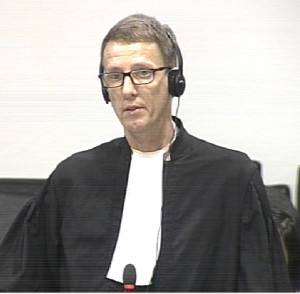
International Nuon Chea Defense Counsel Victor Koppe
Mr. Koppe asked whether he was aware of any epidemics that affected S-21, which the witness denied.
Mr. Koppe moved on and referred to his statement, in which he had said that he treated prisoners whose blood had been drawn.[16] Mr. Thim said that he did not provide them with any special treatment. If prisoners died, he “would be in trouble”. In each building, there would be one prisoner who died in each building every week or in a fortnight. Medics would carry them outside. He did not know whether anyone died as a result of the blood drawing. Mr. Koppe inquired whether he had ever seen an ambulance that could take S-21 prisoners to the hospital. Mr. Thim said that he did not know whether there was such a car. He knew that there were cars that transported prisoners in and out.
Mr. Koppe showed the witness a photograph that showed a house in the background.[17] Mr. Thim answered that he could not remember the house. Mr. Koppe inquired whether this could be the house where the medical unit was stationed. Mr. Thim answered that he forgot it. “I only knew that the medical house was located opposite the building of S-21”.
Asked by the President about clarification about the blood drawing, the witness replied that the senior medics did so, since the more junior members were not allowed to do so. He knew that blood was drawn, since he saw the blood sacks and treated the prisoners. At this point, the President adjourned the hearing for a break.
Health conditions at the prison
After the break, the President issued an oral ruling on the admitting of the underlying documents of E393.2. The defense’s request to delay 2-TCW-906’s testimony was denied. Thus, 2-TCW-808 and 2-TCW-906 would be heard as scheduled. Following their testimony, there would be an adjournment in the week from May 9 until May 12, followed by the scheduled judicial recess of May 13 until May 20. After this hearing, witnesses 2-TCW-816 and 2-TCW-916 would be heard.
The floor was granted to Nuon Chea Defense Counsel. Mr. Koppe gave reference for the question about Duch having feared epidemics. [18] International Civil Party Lead Co-Lawyer Marie Guiraud said that this paragraph did not refer to the beriberi disease, and that beriberi was not a contagious disease. The questions then continued.
Answering a question by Mr. Koppe, Mr. Thim said that he had neither heard of a Special Prison, nor did he know about prisoners being imprisoned outside the compound. Nor had he heard of prisoners becoming medics. Mr. Koppe inquired whether he had heard of a female prisoner called Tang, who might have been a widow with a child and worked as a midwife. Mr. Thim said he did not know about this and only knew about male medics. Mr. Koppe referred to the witness’s Written Record of Interview and wanted to know more about women and children.[19] He saw children who were detained together with their children, but “they were not too young”. He estimated that there were around 20 of them. He would give medicine to them when they were ill. These prisoners were detained in an open room and not shackled or handcuffed. He did not ask the women whether their husbands were also detained there. With this, Mr. Koppe finished his line of questioning.
Khieu Samphan Defense Counsel asked about his testimony that two elderly men had collected healing herbs.[20] He confirmed that these were traditional healers. The production unit was located in Ta Khmao. On the ground floor, there was a grinder with which they produced the rabbit drop pellets. This production unit was in a building. After working there, he was transferred to S-21.
After his departure the center for three months, someone he knew was shackled at S-21. He did not know what happened to him. He knew him, since he was working with him before. Ms. Guissé then asked when he treated the commanders.[21] Mr. Khim replied that he assisted another medic inserting the needle inside a house.
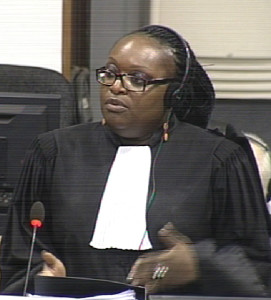
International Khieu Samphan Defense Counsel Anta Guissé
Ms. Guissé showed a photograph to the witness.[22] He said that there was an office opposite of the gate with a tile roof. The entrance was used by him to enter the compound. The building where the sick prisoners were treated was located around 400 to 600 meters away. Ordinary staff, which included him, were not allowed to go into that medical depot. He confirmed that his chief brought the medicine. Ms. Guissé said that he had talked about some antibiotics and a red liquid to clean wounds.[23] She asked whether these were provided to him by his chief, which he confirmed. He did not know where his chief retrieved the medicine from. She wanted to know how he knew that the medicine was French.[24] Mr. Khim replied that his chief told him that the medicine had expired. The expired antibiotic medicine were intended to be used to clean the wounds. He knew penicillin and said that at the time they referred to the medicine as P-Medicine. Penicillin was French, he said, and stored in bottles. They had sufficient medicine and they used it until the Vietnamese arrived.
He did not have contact with members of other groups. She asked whether he remembered a woman who practiced acupuncture, which he did not. He did not participate in other meetings and just focused on distributing medicine. At this point, Ms. Guissé finished her line of questioning.
The President thanked the witness and dismissed him. After the break, the testimony of 2-TCW-906 would be heard.
New Witness: Him Huy
After the break, the President corrected the oral ruling of last session. He said that 2-TCW-808 should not have been mentioned, since this witness was not mentioned in the request. He then ordered to usher in the next witness.
Witness Him Huy was born in 1955 was born in Kandal Province. The Prosecution was granted four sessions to question the witness. Senior Assistant Prosecutor Travis Farr inquired about his duties after the fall of Phnom Penh. Mr. Huy said that his unit was based in Ta Khmao after the fall of Phnom Penh. Unit 176 was transformed into marine forces and he was “afraid of being part of the marine”, since he was “afraid of crocodiles”. He did not know why he was transferred to the navy. He fled to his house on three occasions. The President instructed the witness to give precise answers.
Mr. Farr asked whether he recalled the work at dykes and wanted to know how long this lasted.[25] Mr. Huy replied that he worked behind an electricity building to build dykes. He went there by bike from Psar Thmei. He worked there in the morning until 11 am and then from 2 pm onwards. He also worked on the rice field. During the rainy season, he was sent to the marine, sent back to Psar Thmei and then sent to S-21. He was hospitalized before he was sent to his unit. He worked on the rice field between 1975 and 1976. Mr. Farr said that he had testified having come to S-21 in late 1976.[26] Mr. Huy replied that his memory was not good and that it happened some time in 1976. Hor, commander of his battalion or regiment, told him to go to S-21. Mr. Farr asked whether he talked about the same Hor who was the deputy of S-21. He replied that “there was only Hor”. This person was blind on one eye. He confirmed that it was the same Hor as the deputy of S-21. He arrived at night time, perhaps 8 pm, at the compound. He confirmed that it was the location that is located Tuol Sleng today and that was a school building before.[27] Mr. Farr referred to Duch’s testimony. Duch had said that he had relocated the office from the corner of 360 to the Ponhea Yat college compound in March or April 1976.[28] The witness had not heard the name of this highs school before. It was referred to Tuol Svay Pray high school later.
Joining the guards
He met guards upon his arrival. Later, cadres from divisions were arrested and sent to the prison. Some messengers were also brought in. He was also part of a messenger unit. Some forces were tasked as “borrowing forces” from the division 703. Some forces were arrested and did not return to their former base. Instead, they formed the messenger unit at the prison. There was a 100-Men-Unit that was tasked to guard outside and inside the compound. The buildings on the compound were to hold the prisoners. The locations to interrogate the prisoners were outside the compound.
Asked about the boundaries of the prison, Mr. Huy said that it bordered with “the big road” in the east, in the north with the Chinese hospital, to the west with another road and to the south with the Toul Tompoung Pagoda. He was based to the south of the compound initially, but was posted to receive the prisoners close to the sewage canal later. He was in charge of raising ducks and looking after vehicles there. Mr. Far inquired whether it was correct that his house was located at the Sambok Khmum Radio Station, which the witness confirmed.[29] He had to receive prisoners there. He went into the compound only a few times, since one of his leg was impaired and he could not walk up the buildings. Prisoners were gathered up and sent into the compound. When he walked prisoners from his place to that building, he witnessed prisoners being walked from the prison to the building for interrogation.
Killing Sites
If people were to be killed, they would be killed to the west of the prison compound. Pits were dug for the executed prisoners by Peng and his subordinates. This was under the direct order of Duch, as the latter was the chief of the prison. His orders were relayed through Hor and then through Peng, who was the chief of the guarding unit. The main chief was Peng and his deputy was Phal. Phal was transferred to the chief of Prey Sar later. In the 100-Men-Unit, there were more than 100 men. He was part of this unit by being part of the guarding unit.
“Prisoners were normally taken out to be killed at around 8 and 9 pm”.
This happened once every week or every two weeks. “Only after the prisoners gave the full confessions to the interrogators”. He knew this through Thy, who was in charge of holding the prisoners’ lists. There were between 50 and 100 prisoners who were killed every time. He was not aware of the details of groups of prisoners, since this was not his task.
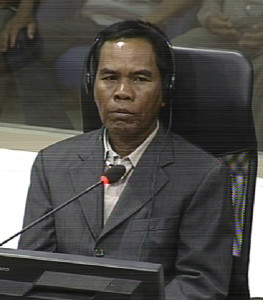
Witness Mak Thim
Mr. Farr asked whether he had participated in the killings to the west of the high school compound. At this point, the duty counsel interjected and said that this question might lead to self-incrimination. Peng, who was in charge of the guards in front of the compound, was responsible for that task. His unit was mainly responsible for receiving prisoners who were brought in.
There was also a burial site to the south of the compound. This was around 100 meters away. The unit that was responsible for guarding inside the compound was responsible for killing prisoners there. They would take the prisoners out at night time. There were no other locations except Choeung Ek where people were executed.
Choeung Ek
Mr. Farr took this opportunity to ask about Choeung Ek and wanted to know how long it took to take prisoners there. He replied that it took around half an hour to go there. Choeung Ek became an execution site in 1977 or 1978 and lasted until the fall of the regime in 1979. He could not recall when exactly it started. There was a team led by Teng that was based at Choeung Ek. Mr. Farr inquired about Tay Teng. Mr. Huy did not know about Tay Teng’s biography. Ta Hor appointed Teng to be the supervisor at Choeung Ek. Duch gathered forces and sent them to that location. If one prisoner was gone when the witness transported the prisoners, he would be asked by Hor to inspect the case. One time, one prisoner disappeared and he was invited to a meeting to discuss the incident. Mr. Huy was blamed for the disappearance of the prisoner, who had fled while being tied. Someone had said that Him Huy had a responsibility in designating Tay Teng as a supervisor at Choeung Ek.[30] Mr. Huy disputed this. Duch, Hor, Peng and Phal went to “do the job”, while Mr. Huy was only in charge of another unit, he said. He was in charge of transporting the prisoners and was to report the names of the prisoners. “If one prisoner was gone from the list, I would be responsible”.
“Hor was in charge of doing the job”.
Prey Sar
Prey Sar extended from Choeung Ek and reached the Prey Sar prison. It reached the river in the east. The cattle and field was under the responsibility of his group. It was originally under the authority of Division 703. Later, it was under the responsibility of S-21. Prey Sar was used for producing rice. When Mr. Farr started reading out an excerpt to the witness, Mr. Koppe interjected and said an open question should be asked first.[31] Mr. Farr repeated his question: why were people sent to Prey Sar? Mr. Huy replied that people were removed from their units and sent to Prey Sar. They went to Prey Sar temporarily. They were accused of having committed mistakes. S-21 members were removed and sent to Prey Sar. Those working on the field were arrested and sent back to S-21. The 100-Member-Unit chief was in charge of Prey Sar.
Mr. Koppe said that the witness was mixing post-1979 and pre-1979 knowledge. Mr. Farr asked whether he knew who the commander was of “Big Huy”. He replied that it was Hor, who was the deputy of S-21. He learned this through the “hierarchy of that compound”. He did not remember an alternative name of Big Huy. When Mr. Farr asked him whether he knew Huy Sre, he said that this referred to the location he worked at. The witness, Him Huy, was known as “Small Huy”. When he went to Prey Sar, the witness’s group was reassigned to build a dam at Prey Sar. He was working together with the other Huy. On one occasion, there was a flood there. One day, he was asked to drive a vehicle to collect prisoners at Prey Sar, but midway his car went upside down. He was told to get the prisoners to Choeung Ek. They were sent there for execution. However, the car did not reach Prey Sar, since it went upside down midway. There were other occasions where he went there to dig dykes. Hor would issue the orders.
Mr. Farr asked whether there was a person called Ouch at S-21. He replied that Pouch was the former chief, but was killed by Duch later.
Orders
He would receive letters and forward them to Thy. After this, he brought the prisoners to Suos Thy, where they would be registered and would have their photographs taken. There were guards accompanying the prisoners. He saw letters, but would not check their content. Sometimes it was said that the prisoners were from the north or state ministries. Those who had just come from abroad were brought to S-21. Some were arrested right at “Duch’s location”, but some were sent from somewhere else. He did not know how long the people were in the country before being sent to S-21.
With this, Mr. Farr concluded his questioning for today and the President adjourned the hearing. It will continue tomorrow, May 4, 2016, at 9 am with the testimony of Him Huy.
[1] E3/8461
[2] E3/7666, at 00163818 (KH), 00163822 (EN), 00235797 (FR).
[3] E393.2, 10.143: Chheng Pao.
[4] E3/313.31, E3/3181, E3/8481, E3/8460, at 00068899 (KH), 00843443-44 (EN), 00846998 (FR).
[5] E3/7673, at 00163713 (KH), 00401872-73 (EN), 00305214 (FR).
[6] E3/3181, page 3.
[7] E3/7673, at 00163712 (KH), 00401871 (EN), 00305123 (FR).
[8] E3/2285, at 0009212 and 9167 (KH), 00873432 and 332 (EN); E3/2164
[9] E3/7463, at 11:55; E3/7467, Testimony of 11 August 2009, at 10:11:20.
[10] Paragraph 457 of the Closing Order.
[11] E3/7673., 001673 70 (EN)
[12] E3/7673.
[13] E3/8386, at 00002640 (KH), 0521634 (EN), 00532736 (FR).
[14] E3/7673, at 00401870 (EN), 00163711 (KH), 00305212 (FR)
[15] E3/352, at 00195708 and 710 (EN), 00186560 and 62 (KH), 00401889 and 91 (FR).
[16] E3/7673, at 00163712 (KH), 00401869 (EN), 00305213 (FR).
[17] E3/9431, at 00198080 (EN), 00181447 (KH), 00181501 (FR).
[18] Judgment Case 001, paragraph 184 and E3/5766, at 00165437 (EN), 00165445 (FR).
[19] E3/7673, at 00401872 (EN), 00163713 (KH), 00305214 (FR).
[20] Testimony of Mak Thim, May 2 2016, at 15:17.
[21] Ibid., at 15:26.
[22] E3/9431, at 00181450 (FR), 00198029 (EN), 00181396 (KH).
[23] 15:46:04
[24] E3/7663, at 00305014 (FR), 00163713 (KH), 00401873 (EN).
[25] E3/7461, at 09:32.
[26] E3/7461, at 09:35.
[27] E3/7461, at 09:35.
[28] E3/5792, at 11:18.
[29] E3/5155, at 00161588 (EN), 00148081 (FR), 00146636 (KH).
[30] 28 February 2008.
[31] E3/5155, 00161589 (EN), 00146673 (KH), 00148081 (FR).
Featured Image: Witness Mak Thim and his duty counsel (ECCC: Flickr).
